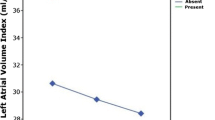Abstract
Purpose
Several studies have demonstrated that left ventricular diastolic dysfunction (LVDD) and left atrial pressure (LAP), as a surrogate marker of LVDD, were associated with atrial fibrillation (AF) recurrence following radiofrequency catheter ablation (RFCA) for AF. In this study, we aimed to investigate the individual impact of several left ventricular diastolic function parameters on outcomes of cryoablation for paroxysmal AF using second-generation cryoballoon.
Methods
One hundred seventy patients who were scheduled for cryoablation with second-generation cryoballoon were included in this prospective study. All patients underwent comprehensive transthoracic and transesophageal echocardiographic examinations during sinus rhythm a day before catheter ablation. LAP was measured via transseptal sheath at the beginning of the ablation procedure.
Results
One hundred seventy patients (57.09 ± 11.80 years, 47.06 % male) were involved in the study. At a median follow-up of 19 months, when blanking period of 3 months was considered, freedom from AF after a single ablation procedure was 84.71 %. Patients with AF recurrence had significantly greater left atrial volume index (LAVI) (p = 0.005) and LAP (p < 0.001). Patients with AF recurrence had lower septal eʹ wave (p = 0.013), and higher E/eʹ ratio (p = 0.014). LAVI (p = 0.007) and LAP (p = 0.006) were independent predictors of AF recurrence. A cut-off value of 13.50 mmHg for LAP measured during the procedure was associated with a sensitivity and specificity of 80.8 and 84.7 % (p = 0.005) for predicting AF recurrence.
Conclusions
Pre-procedural LAVI and procedural LAP measurement have clinical importance in predicting AF recurrence in patients undergoing cryoablation with second-generation cryoballoon. Effectiveness of cryoablation is reduced in patients with greater LAVI and LAP.

Similar content being viewed by others
References
Jais, P., Peng, J. T., Shah, D. C., Garrigue, S., Hocini, M., Yamane, T., et al. (2000). Left ventricular diastolic dysfunction in patients with so-called lone atrial fibrillation. Journal of Cardiovascular Electrophysiology, 11(6), 623–625.
Tsang, T. S., Gersh, B. J., Appleton, C. P., Tajik, A. J., Barnes, M. E., Bailey, K. R., et al. (2002). Left ventricular diastolic dysfunction as a predictor of the first diagnosed nonvalvular atrial fibrillation in 840 elderly men and women. Journal of the American College of Cardiology, 40(9), 1636–1644.
Kosiuk, J., Breithardt, O. A., Bode, K., Kornej, J., Arya, A., Piorkowski, C., et al. (2014). The predictive value of echocardiographic parameters associated with left ventricular diastolic dysfunction on short- and long-term outcomes of catheter ablation of atrial fibrillation. Europace, 16(8), 1168–1174.
Cha, Y. M., Wokhlu, A., Asirvatham, S. J., Shen, W. K., Friedman, P. A., Munger, T. M., et al. (2011). Success of ablation for atrial fibrillation in isolated left ventricular diastolic dysfunction: a comparison to systolic dysfunction and normal ventricular function. Circulation. Arrhythmia and Electrophysiology, 4(5), 724–732.
Pezawas, T., Binder, T., Ristl, R., Schneider, B., Stojkovic, S., Schukro, C., et al. (2015). Selection for atrial fibrillation ablation: importance of diastolic function grading. Journal of Cardiology, 65(6), 479–486.
Ejima, K., Shoda, M., Arai, K., Suzuki, A., Yagishita, D., Yagishita, Y., et al. (2013). Impact of diastolic dysfunction on the outcome of catheter ablation in patients with atrial fibrillation. International Journal of Cardiology, 164(1), 88–93.
Hirai, T., Cotseones, G., Makki, N., Agrawal, A., Wilber, D. J., & Barron, J. T. (2014). Usefulness of left ventricular diastolic function to predict recurrence of atrial fibrillation in patients with preserved left ventricular systolic function. American Journal of Cardiology, 114(1), 65–69.
Linhart, M., Lewalter, T., Mittmann-Braun, E. L., Karbach, N. C., Andrie, R. P., Hammerstingl, C., et al. (2013). Left atrial pressure as predictor for recurrence of atrial fibrillation after pulmonary vein isolation. Journal of Interventional Cardiac Electrophysiology, 38(2), 107–114.
Bergau, L., Vollmann, D., Luthje, L., Sohns, J. M., Seegers, J., Sohns, C., et al. (2014). Measurement of left atrial pressure is a good predictor of freedom from atrial fibrillation. Indian Pacing Electrophysiol Journal, 14(4), 181–193.
Park, J., Joung, B., Uhm, J. S., Young Shim, C., Hwang, C., Hyoung Lee, M., et al. (2014). High left atrial pressures are associated with advanced electroanatomical remodeling of left atrium and independent predictors for clinical recurrence of atrial fibrillation after catheter ablation. Heart Rhythm, 11(6), 953–960.
Aytemir, K., Gurses, K. M., Yalcin, M. U., Kocyigit, D., Dural, M., Evranos, B., et al. (2015). Safety and efficacy outcomes in patients undergoing pulmonary vein isolation with second-generation cryoballoon. Europace, 17(3), 379–387.
Lang, R. M., Bierig, M., Devereux, R. B., Flachskampf, F. A., Foster, E., Pellikka, P. A., et al. (2005). Recommendations for chamber quantification: a report from the American Society of Echocardiography's Guidelines and Standards Committee and the Chamber Quantification Writing Group, developed in conjunction with the European Association of Echocardiography, a branch of the European Society of Cardiology. Journal of the American Society of Echocardiography, 18(12), 1440–1463.
Arya, A., Hindricks, G., Sommer, P., Huo, Y., Bollmann, A., Gaspar, T., et al. (2010). Long-term results and the predictors of outcome of catheter ablation of atrial fibrillation using steerable sheath catheter navigation after single procedure in 674 patients. Europace, 12(2), 173–180.
Gurses, K. M., Yalcin, M. U., Kocyigit, D., Evranos, B., Ates, A. H., Yorgun, H., et al. (2015). Red blood cell distribution width predicts outcome of cryoballoon-based atrial fibrillation ablation. Journal of Interventional Cardiac Electrophysiology, 42(1), 51–58.
Shi, Y., Ducharme, A., Li, D., Gaspo, R., Nattel, S., & Tardif, J. C. (2001). Remodeling of atrial dimensions and emptying function in canine models of atrial fibrillation. Cardiovascular Research, 52(2), 217–225.
De Jong, A. M., Maass, A. H., Oberdorf-Maass, S. U., Van Veldhuisen, D. J., Van Gilst, W. H., & Van Gelder, I. C. (2011). Mechanisms of atrial structural changes caused by stretch occurring before and during early atrial fibrillation. Cardiovascular Research, 89(4), 754–765.
Kalifa, J., Jalife, J., Zaitsev, A. V., Bagwe, S., Warren, M., Moreno, J., et al. (2003). Intra-atrial pressure increases rate and organization of waves emanating from the superior pulmonary veins during atrial fibrillation. Circulation, 108(6), 668–671.
Kanda, T., Masuda, M., Sunaga, A., Fujita, M., Iida, O., Okamoto, S., et al. (2015). Low left atrial appendage flow velocity predicts recurrence of atrial fibrillation after catheter ablation of persistent atrial fibrillation. Journal of Cardiology, 66(5), 377–381.
Fukushima, K., Fukushima, N., Ejima, K., Kato, K., Sato, Y., Uematsu, S., et al. (2015). Left atrial appendage flow velocity and time from P-wave onset to tissue doppler-derived A' predict atrial fibrillation recurrence after radiofrequency catheter ablation. Echocardiography, 32(7), 1101–1108.
Combes, S., Jacob, S., Combes, N., Karam, N., Chaumeil, A., Guy-Moyat, B., et al. (2013). Predicting favourable outcomes in the setting of radiofrequency catheter ablation of long-standing persistent atrial fibrillation: a pilot study assessing the value of left atrial appendage peak flow velocity. Archives of Cardiovascular Diseases, 106(1), 36–43.
Agmon, Y., Khandheria, B. K., Meissner, I., Petterson, T. M., O'Fallon, W. M., Wiebers, D. O., et al. (2002). Are left atrial appendage flow velocities adequate surrogates of global left atrial function? A population-based transthoracic and transesophageal echocardiographic study. Journal of the American Society of Echocardiography, 15(5), 433–440.
Acknowledgments
None.
Author information
Authors and Affiliations
Corresponding author
Ethics declarations
Conflict of interest
The authors declare that they have no competing interests.
Funding
None.
Rights and permissions
About this article
Cite this article
Evranos, B., Kocyigit, D., Gurses, K.M. et al. Increased left atrial pressure predicts recurrence following successful cryoablation for atrial fibrillation with second-generation cryoballoon. J Interv Card Electrophysiol 46, 145–151 (2016). https://doi.org/10.1007/s10840-016-0107-8
Received:
Accepted:
Published:
Issue Date:
DOI: https://doi.org/10.1007/s10840-016-0107-8




